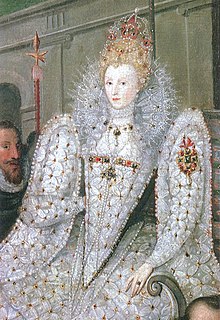The end of the Elizabethan Age and the beginnings of the Stuart Dynasty
by Richard Denning
In 1600 Elizabeth, the last Tudor monarch, had been Queen for 42 years. Many in the kingdom had known no other monarch. At the height of her power during the triumph over the Spanish Armada in 1588, she had created an image of an almost immortal majesty. Yet in the latter years her influence and hold on power were weakening.

This was a period of unrest. Wars with Spain and conflict in Ireland rumbled on at great cost. This put a strain on the economy that was not helped by poor harvests. At the same time Elizabeth had become more hard line in her approach to religious non conformists – in particular Catholics. The 1590s had been an era of priest holes and raids in the night. Needing money to pursue her policies and not wanting to take it from a parliament who might impose restrictions on her she instead employed a system of patronage whereby she gained money from supporters in exchange for positions of power and influence and the granting of monopolies which made some men rich at the expense of many others and was a deeply unpopular policy.
She maintained an illusion of peace and tranquillity with a combination of propaganda and the suppressing of dissent by the use of a network of informers. Nevertheless support from parliament and the people was waning.
In these last years her senior advisor Robert Cecil began making plans for the succession. Elizabeth was not willing to discuss her choice of heir so Cecil had to move carefully. He approached James VI of Scotland who was descended from Elizabeth’s grandfather, Henry VII via Margaret his daughter. He encouraged James to flatter Elizabeth and charm seemed to work because Elizabeth although not as such naming James as heir pretty much implied it.
In March 1603 Elizabeth’s health deteriorated probably at least in part due to the death of close friends. She died on 24th and James was named King the same day.
James I

England reacted enthusiastically to the new King and James’ procession south which took a month and involved lavish entertainment by many nobles was accompanied by huge crowds. Even larger crowds welcomed him in London and in July he was crowed James I of England.
One early success of his reign was managing to bring to an end the eternal wars with Spain. In other areas he was not so successful. He yearned to unite England and Scotland as one Kingdom and styled himself King of Britain but Parliament would never grant him this title.
It was not only Parliament who were unhappy with James. There had been a hope that he would relax the restrictions on the Catholics but he failed to really deliver on this and as a result these first few years of his reign involved several plots by unhappy catholics.
Main Plot
This began as early as July 1603. Spain offered to send funds via Lord Cobham to help with raising a regiment of troops which would replace James with his catholic cousin Arabella. This plot did not seem to have got very far but was discovered when the conspirators of the Bye plot were questioned. Sir Walter Rayleigh was implicated in the Main plot and imprisoned in the Tower and finally executed in 1618.
Bye Plot
In this plot a Catholic priest William Watson tried to kidnap James and force him to repeal the anti-catholic measures that were in power. Other Catholics betrayed the main conspiritors so as to avoid widespread retribution against them.
The Gunpowder Plot
The most famous of these plots to overthrow the protestant James was of course the Gunpowder Plot of 1605. 13 conspirators lead by Catesby and including Guy Fawkes (who had the charge of the gunpowder). Gunpowder was smuggled into a cellar beneath the House of Lords and it was planned that during the opening of Parliament on November 5th it would been blow up. This would kill all of the house of Lords, Commons and the King. In the chaos that ensued Princes Elizabeth (James’ daughter) would be crowned as a catholic head of state.
The plot was revealed when one of the plotters sent a message to Baron Monteagle warning him to stay away from Parliament. The buildings were searched and Fawkes found.
After the plots
James’ popularity rose again after these plots and his advisers used this to squeeze concessions and money out of parliament but soon again the King and his Parliament were at loggerheads. Falling out with parliament would be a regular feature of his reign and we now see the beginning of the conflicts between the sovereignty of King and Parliament that would one day lead to civil war.
Other events:
1600: Shakespeare’s A Midsummers night’s dream was first performed
1602: Bodlein Library in Oxford opened
1606 The first Union Flag designed
1607 God Save the Queen first sung
1607 Jamestown founded in Virginia
1609 First Newspaper printed in Germany
Coming next week: 1610 to 1619
This article is one of a series connected with the release in August 2011 of the new paperback of The Last Seal my historical fantasy set during the Great Fire of 1666.


Related Articles
No user responded in this post